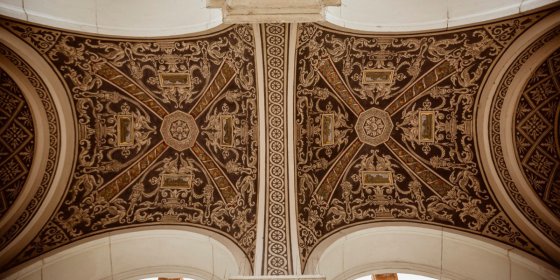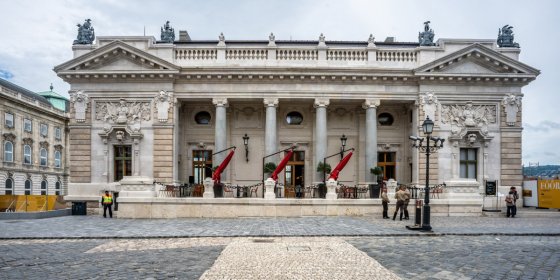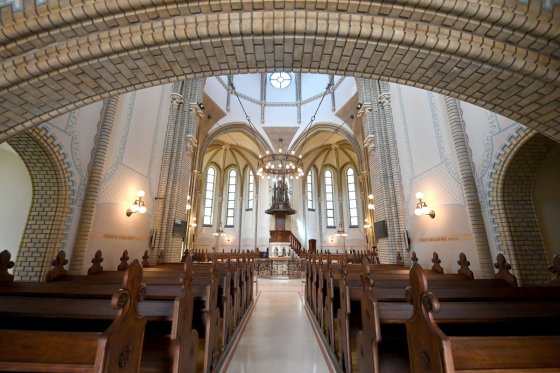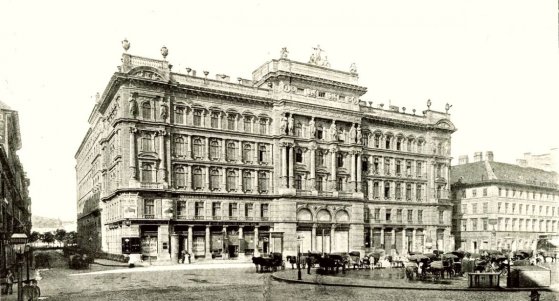 The „intertwined history” of the bridges and the city of Budapest
Which ideas and events have shaped the fate of bridges of Budapest and the cityscape? Alongside many other interesting facts, this question is also answered this newly published book by the Budapest City Archives, which introduces the history of bridges in Budapest.
The „intertwined history” of the bridges and the city of Budapest
Which ideas and events have shaped the fate of bridges of Budapest and the cityscape? Alongside many other interesting facts, this question is also answered this newly published book by the Budapest City Archives, which introduces the history of bridges in Budapest.
Architecture
 A statue of Mozart and Dvořák once adorned the facade of Ellinger Palace
A statue of Mozart and Dvořák once adorned the facade of Ellinger Palace
July 18, 2021 at 10:00 AM
At first glance, people can only see one dilapidated house in Terézváros, at 2/B Németh László Street. However, behind the dropping plaster of the once ornate Ellinger Palace, special stories emerge. Half of the house was owned by the violinist and internationally renowned music teacher, Gusztáv Ellinger, while the other half was the architect Ferenc Novák's, who became known in the 1890s for his plans for the Gellért Hill Funicular.
Teleki Blanka opened the first school for girls in Pest in a building on Szabadság Square that still stands today
July 16, 2021 at 9:00 AM
A peculiar twist of fate is that Blanka Teleki opened the first education institution for girls in Pest next to the Újépület ('new building') in Lipótváros, that served as a military barracks, which became her prison in 1851, because according to the imperial authorities the 1848 revolution started from her educational institution. The building, which still stands on the former Promenade, later housed a bank, then the economic police of the Ministry of the Interior, and today the headquarters of the Catholic Camp Bishopric.
Next year, the construction of the new Museum of Transport the area of the Északi Járműjavító may begin
July 15, 2021 at 5:30 PM
The Északi Járműjavító (Northern Locomotive Workshop) on Kőbányai Road is saying goodbye with a special temporary exhibition: the building can be seen in its current condition until October, and the exhibition will show not only the life of the former workshop, but also the plans of the new Museum of Transport. The new cultural district, centered on the museum and the existing Eiffel Workshop, will be transformed from the locomotive workshop that closed in 2009. The area will also be connected to Népliget and a new railway station is planned.
The sports centre in the Inner City was completed - Special architectural solutions were applied in Vadász Street
July 13, 2021 at 4:00 PM
The Sports and Adventure Centre has been established by the Inner City Local Council at 30 Vadász Street. In addition to the sports fields, the new facility will have a 4-lane, 25-metre pool, a training pool and a thermal water wellness area, which will be fed by its own thermal water well. Great emphasis was placed on ecological and energy efficiency aspects when designing the building. As a result of special architectural solutions, a number of sports departments have been incorporated into the small floor area.
The station building in Kelenföld escaped destruction
July 9, 2021 at 2:00 PM
The Hungarian Museum of Science, Technology and Transport will create a railway history exhibition space in the listed 137-year-old building. According to the plans, in addition to the former station building, a museum garden will be created and the house will also receive an extension: a terrace serving as a lookout point, a train viewing place. The building permit has now been granted to the investment.
The Academy operated in several palaces in Pest before moving into its headquarters
July 7, 2021 at 11:00 AM
Renovation of the headquarters of the Hungarian Academy of Sciences will begin soon. The Neo-Renaissance palace was built between 1862 and 1865, according to the plans of Berlin-based architect Friedrich August Stüler, and execution was controlled by renowned architects such as Miklós Ybl and Antal Szkalnitzky. The company of scientists waited forty years for the independent headquarters. The institution, founded in 1825, rented rooms in the city's famous buildings until the palace next to the Chain Bridge was completed.
From the Opera House to the Parliament - The decorative painting of several representative buildings is the work of Róbert Scholtz
July 5, 2021 at 9:30 AM
Ornate public buildings and palaces were defining parts of the cityscape of Pest-Buda, which became a more and more civilized city and a metropolis. Róbert Scholtz, a decorative painter, played an important role in decorating many representative buildings, and his work is famous for, among other things, the St. Stephen's Hall, which was destroyed in 1945, but will soon be rebuilt.
The first Hungarian international football match was played at the Millenáris in Zugló - The field called the cradle of Hungarian sports is 125 years old
June 30, 2021 at 4:00 PM
Today, when it comes to the Millenáris everyone thinks of the popular Buda park, although the Pest side also has its own Millenáris. The Millenáris in Zugló, which is the first sports field in Budapest, has been operating for 125 years, and many also refer to it as the cradle of Hungarian competitive sports. The tilted winding cycling track, the velodrome, was already one of the most modern tracks of its time when it was built, after its reconstruction in 1927, tens of thousand supporters flooded the grandstand during the world championship organized here. The first public international football match in Hungary was held here.
A decades-old plan comes to life – A tunnel connecting Széll Kálmán Square with Városmajor
June 25, 2021 at 9:00 AM
The construction of the new pedestrian crossing connecting Széll Kálmán Square with the Postapalota (Postal Palace) and Városmajor started last autumn, the two ends of which met under Várfok Street almost a month ago. The tunnel, which is expected to be completed by the end of the year, will not only provide an unobstructed passage for pedestrians and cyclists in the area to Városmajor but will also create a new entrance to the former Postapalota, also known as the Buda Palace.
Facade of the residential building that houses the Radnóti Theater is being renovated
June 24, 2021 at 4:00 PM
The facade and the balcony of the building at 11 Nagymező Street in Terézváros have become accident-prone, leading to the renovation. During the works, the missing limestone slabs and balcony slabs on the facade will be replaced, and the work is expected to be completed by the end of the summer.
Built as a church of gratitude, demolished by Rákosi – the Regnum Marianum church was consecrated 90 years ago
June 22, 2021 at 9:30 AM
The replica of the Hungarian Holy Crown as a dome ornament was one of the unique features of the Regnum Marianum church, which was consecrated 90 years ago. Twenty years after its consecration on 14 June 1931, the sacral building was condemned to be demolished by the communist dictatorship, and its walls were blown up. There are few Hungarian churches of the 20th century in the Carpathian Basin, whose tragic fate could be associated with as much emotion as the history of the Regnum Marianum in Városliget.
Ideology fuelled destruction in Buda Castle after World War II
June 19, 2021 at 8:30 AM
The siege of Budapest was one of the most brutal battles of World War II, with the Castle District suffering the greatest damage. Only 1,400 of the approximately 6,500 flats standing in the vicinity of Castle Hill remained intact. And the devastation continued after the war: the communist dictatorship destroyed many buildings for ideological reasons, even though they could have been saved or rebuilt. Many iconic buildings, including several churches and the Castle Garden, fell victim to communist "restoration".
The Fehérvár Roundel is being rebuilt
June 17, 2021 at 3:00 PM
The reconstruction of the Fehérvár Roundel in Buda Castle and the renovation of the surrounding castle walls has started. During the works, the equestrian statue of General Artúr Görgei was transported to be restored. It will be returned to the walls in its former glory.
Lion, sparrowhawk, crane – Ancient symbols from coats of arms tell the story of the past of noble families in the Magnates' Quarter
June 17, 2021 at 9:30 AM
Although in 1947, the communist regime banned the use of noble forenames and badges, including private coats of arms, fortunately, these were not removed from the former aristocratic palaces. Ancient symbols, often dating back centuries, referred to the owner's family, their role in Hungarian history and also served aesthetic purposes on the buildings. In the second half of the 19th century, the Hungarian aristocracy enjoyed building around the National Museum, so several buildings with family coats of arms and their motifs can be found in the quarter. These can be seen in the palaces of the Festetics and Károlyi families in Pollack Mihály Square.
The bricklayer building the Town Hall of Buda appears on the Holy Trinity Column
June 15, 2021 at 9:30 AM
Most of the encyclopaedias only describe the life of builder János Hölbling from Buda briefly, although, after the siege of 1686, he took an active part in the reconstruction of the city and the construction of the former Buda Town Hall is also connected to his name. He was such a respected professional in his day that his figure even appears on the Holy Trinity Column in Holy Trinity Square (Szentháromság). The builder of Buda died 285 years ago.
Renovated Rumbach Sebestyén Street Synagogue opened
June 10, 2021 at 4:00 PM
The renovated Rumbach Sebestyén Street Synagogue was opened as a renewed sacred, communal and cultural space. The synagogue, built in 1872 according to the plans of Otto Wagner, stood empty for decades, and its reconstruction was completed last year.
Guardians of Buda Castle – traditions of the Hungarian Royal Guards come to life in the café of the Guard House
June 10, 2021 at 10:00 AM
After almost fifty years, the Guard House (Főőrség) once again stands in full beauty on the western side of the Hunyadi courtyard. The recently opened café revives the traditions of the Hungarian Royal Guards. The exhibition on the first floor presents the history of the military unit of Hungary with the help of original uniforms, weapons, and copies of contemporary documents. The café's menu evokes the heyday of the Budapest café culture. Its interior refers to the colours of the guard's uniforms, which was one of the top Hungarian national uniforms. Pestbuda asked managing director István Bottyán about the past and present of the renewed Guard House.
Renovation of Szilágyi Dezső Square Reformed Church completed
June 6, 2021 at 6:00 PM
After the external restoration carried out a few years ago, the interior renovation of the Reformed Church on Szilágyi Dezső Square has been completed. Consecrated 125 years ago, the church, designed by Samu Petz, has been given restored benches, glass windows and new floor tiles.
Vendors once sold their goods on Csarnok Square in Ferencváros, where shoppers and tourists now relax
May 26, 2021 at 9:00 AM
Although Csarnok (Market Hall) Square in Ferencváros did not exist before 1896, after the opening of the Central Market Hall, a busy life began on the 9th District's smallest, but all the more special square, where hundreds of graves were unearthed during a 2016 hotel construction, highlighting a small detail of the area's vibrant past.
The Károlyi Palace hosted the country's first large-scale exhibition of applied arts
May 18, 2021 at 9:00 AM
Donations were raised in several places throughout the country to alleviate the damage caused by the floods of February 145 years ago and to help the flood victims. Related to these efforts was the exhibition of applied arts presenting the unique treasures of art, which was organised not in a public collection, but in the palace of Count, Alajos Károlyi built behind the National Museum in May 1876.
Demolition: Irén Psota's birthplace to be destroyed
May 12, 2021 at 2:00 PM
Another detail of the old Budapest is set to disappear, as the demolition of the building at 23/A Tömő Street in Józsefváros will begin soon. The four-storey building, built in the 1880s, in which actress Irén Psota was born, was sold by the local council in 2019, and the new owner has already received a demolition permit.
Neo-Gothic wonder on Üllői Road – Church in Ferencváros designed by Sándor Aigner
May 10, 2021 at 9:00 AM
A large number of architects played a huge role in making Budapest a metropolis. They created numerous beautiful plans between the 1870s and 1910s. Many of our public buildings and dwellings that still stand are the fruits of their work. While this view is generally accepted, the names of several masters have almost been forgotten. Such is the case of Sándor Aigner, who designed many churches as a master of Gothic Revival architecture. His most important work is the Perpetual Adoration Church in Ferencváros.
The famous line of hotels on the Danube Promenade started to develop in the year of the millennium
May 5, 2021 at 9:00 AM
Several hostels and inns awaited local and foreign guests on the banks of the Danube in Pest during the Reform period. What would become the Danube Promenade south of Chain Bridge, was a stronghold of hospitality. Most of the houses constructed in the 1870s were not originally built as hotels, and it was not until the millennium that these developments began in the area. Upscale luxury hotels such as the Grand Hotel Hungária and Bristol awaited guests at the end of the 19th century and from the 1910s, the Ritz.
The imposing palace of Vörösmarty Square – Headquarters of the world-famous Haas Fülöp & Sons Company
April 29, 2021 at 9:00 AM
Fülöp Haas founded the most high-quality carpet manufacturer in the age of dualism in Vienna. The company, which later became world-famous, had two factories in Hungary and a central department store and warehouse in Budapest: one of the most beautiful palaces of today's Vörösmarty Square. The company, which made the production of carpets an applied art, also made the ornate wall tapestry of Saint Stephen Hall in the Royal Palace of Buda Castle, which will soon be reborn in the reconstruction.
Budapest is home to one of the oldest veterinary training institutions in Europe
April 28, 2021 at 2:30 PM
The building complex of the University of Veterinary Medicine Budapest has been serving Hungarian veterinary training for exactly 140 years. The building complex in Erzsébetváros, located between today's Rottenbiller and Bethlen Streets, was designed by Imre Steindl, decorated with Zsolnay majolica and stained glass by Miksa Róth. On the World Day of Veterinarians, 28 April, PestBuda presents the history and building complex of the University of Veterinary Medicine Budapest.
Renewal in Pasarét: renovation of the Franciscan church and the new parish building to be completed in the autumn
April 27, 2021 at 9:30 AM
The life of one of the first modern churches in Budapest may soon be given new impetus: the investment on Pasaréti Square, next to the church designed by Gyula Rimanóczy and completed in 1934, has begun. The project will renew the parish building, create an up-to-date library and community centre that follows the style of the modern church. Due to the works, the 2nd District church will be closed in July-August, the reconstruction is expected to be completed by Autumn.
Renders released – Budapest campus of Pázmány Péter University to open in 2027
April 17, 2021 at 2:00 PM
The campus of the Pázmány Péter Catholic University planned to use the former buildings of the Hungarian Radio will significantly change the cityscape. During the investment, which is expected to be completed by 2027, several significant buildings will be renovated in the area behind the National Museum, such as the Esterházy Palace, which also includes the former Marble Hall of the National Radio and the dilapidated Károlyi Palace. New buildings will also be erected.
Visible work on exterior of Ministry of Finance building begins
April 14, 2021 at 7:30 PM
The monumental reconstruction of the facade and roof structure of the Ministry of Finance on Szentháromság Square and the restoration of the representative interiors is to begin soon. The building, which will be completed by 2023, will follow the designs Sándor Fellner created.
Design renders for renovation of Ministry of Agriculture released
March 24, 2021 at 9:00 AM
The renovation of the Ministry of Agriculture's Kossuth Square building will begin in the summer. The design renders newly published show that the Neo-Renaissance facades will be restored to their original beauty. The previously closed central courtyard will be opened to visitors. Gyula Bukovics designed the palace, and its construction began in 1885, the same year in which construction of the Parliament building on the other side of the square but was completed fifteen years earlier, in 1887.
Sipeki Balás Villa to be restored on Hermina Road
March 21, 2021 at 2:00 PM
The Art Nouveau Sipeki Balás Villa, built between 1905 and 1907, currently the headquarters of the Hungarian National Association of the Blind and Visually Impaired, is to be fully restored. The listed building, designed by Ödön Lechner, will be renovated under supervision for HUF 1.94 billion. The wing attached to it in the 1970s will be demolished and replaced with a new wing.
More articles
 The „intertwined history” of the bridges and the city of Budapest
Which ideas and events have shaped the fate of bridges of Budapest and the cityscape? Alongside many other interesting facts, this question is also answered this newly published book by the Budapest City Archives, which introduces the history of bridges in Budapest.
The „intertwined history” of the bridges and the city of Budapest
Which ideas and events have shaped the fate of bridges of Budapest and the cityscape? Alongside many other interesting facts, this question is also answered this newly published book by the Budapest City Archives, which introduces the history of bridges in Budapest.
 The Bridge Report, which brought a turning point in the history of Budapest
A travel report that changed the history of Pest and Buda, as well as Hungary. The little book contributed to the change of half a thousand years of legal customs and the implementation of an investment of unprecedented size and technical quality. This book was The Bridge Report [Hídjelentés in Hungarian].
The Bridge Report, which brought a turning point in the history of Budapest
A travel report that changed the history of Pest and Buda, as well as Hungary. The little book contributed to the change of half a thousand years of legal customs and the implementation of an investment of unprecedented size and technical quality. This book was The Bridge Report [Hídjelentés in Hungarian].
 Drama on the university wall - The heroic monument was planned 95 years ago
In the constant hustle and bustle of the Egyetem Square in Pest, the students may not even notice the monument that decorates the short section of wall between the church and the central building of ELTE. However, it commemorates their predecessors, the heroes who fought for their country in World War I, and those who heroically helped them. The first design of the dramatically collapsing soldier was born in 1928, ninety-five years ago.
Drama on the university wall - The heroic monument was planned 95 years ago
In the constant hustle and bustle of the Egyetem Square in Pest, the students may not even notice the monument that decorates the short section of wall between the church and the central building of ELTE. However, it commemorates their predecessors, the heroes who fought for their country in World War I, and those who heroically helped them. The first design of the dramatically collapsing soldier was born in 1928, ninety-five years ago.





























